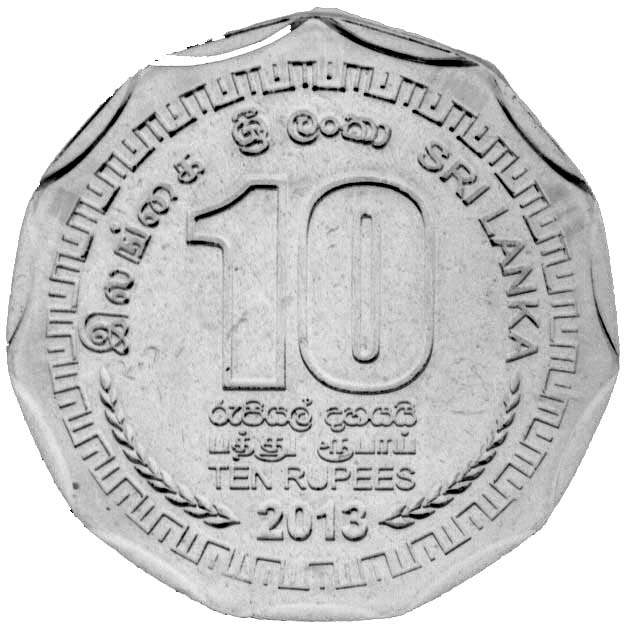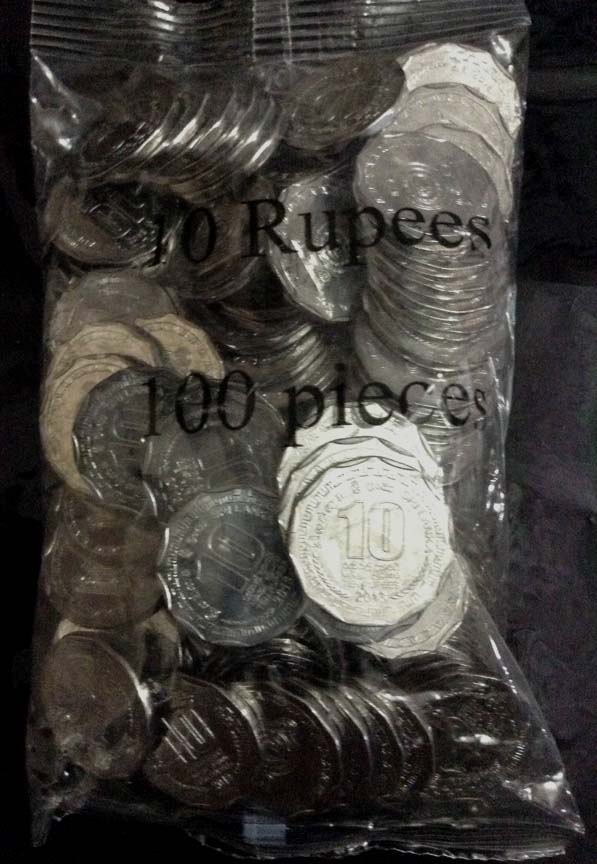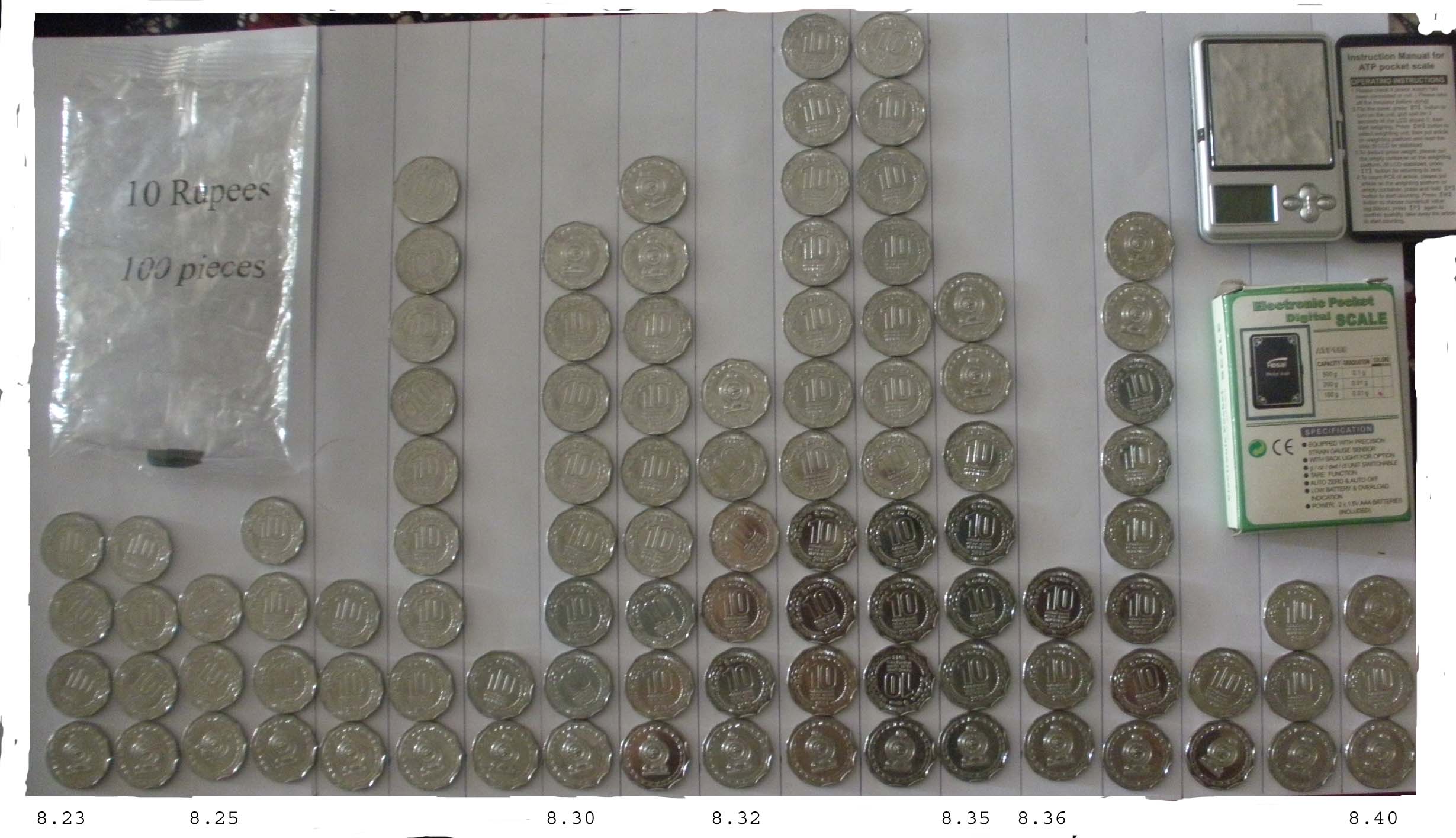| SPECIFICATIONS | |
| Denomination | Ten Rupee |
| Alloy | Stainless Steel AISI 430 |
| Diameter | 26.4 mm |
| Thickness | 2.1 mm |
| Weight | 8.36 gms |
| Shape | 11 sided |
| Edge | Plain |
| DieAxis | 0° |
| Mint | Slovak Mint |


|

|

| ||||||||||||||||||||
| KM #181a | ||||||||||||||||||||||
Obverse : The Armorial Ensign of Sri Lanka within circle of a petal design along periphery with partly raised rim.
Reverse : The large numeral denomination 10 with
රුපියල් දහයයි in Sinhala,
and
பத்து ரூபாய் in Thamil
and TEN RUPEES
below and year of issue at the bottom flanked by ears of paddy on either side..
The country name
ශ්රී ලංකා in Sinhala, centered on top,
இலங்கை in Thamil
on left and SRI LANKA on Right. All within circle of a geometric design along periphery with partly raised rim.
 To replace the Rs10 currency note which was last printed in 2006, in
2010 April CBSL issued a Nickel plated Steel
coin which were Minted at
the Royal Mint in UK with dates 2009 and 2011.
To replace the Rs10 currency note which was last printed in 2006, in
2010 April CBSL issued a Nickel plated Steel
coin which were Minted at
the Royal Mint in UK with dates 2009 and 2011.
This Slovak mint coin has clearly visible differences, with the Royal Mint issue. The Armorial ensign is 7.5% smaller and the denomination numeral 10 is 6% smaller. Many of the other design features are correspondingly slightly smaller. The flat edges on the rim is smaller and the cantilever loop around the 11 sided coin is broken. The high-raise is also less. It will most probably feel different to a blind person.
CBSL records 2 orders of 2013 dated Rs10 coins, minted before and after the 25-district coin series. Rudi Boekel has reported small differences in the letter Sri and the cantilever loop around the 11 sided coin appears less broken. The difference is still subtle to confirm if a new master die has been cut between the two orders.
In contrast to the Royal Mint Plastic bags of 1000 coins, the Slovak mint coins are issued in very convenient cellophane packs of 100 coins, which weighed 835 grams on a digital scale. Printed in Black on pack is 10 Rupees - 100 pieces. Five of these packs were enclosed in a larger pack with Printed in Black 10 Rupees - 500 pieces in two lines.
The AISI 430 Stainless Steel is attracted by magnets and currently the most used ferritic stainless steel grade in the world. Grade 430 is medium chromium (16%-18% by weight), combining good corrosion resistance and formability characteristics with useful mechanical properties. It attains its maximum corrosion resistance when in the highly polished or buffed condition. It is not usually recommended for Grade 430 to be subjected to exterior exposure, but it performs well in mild indoor environments. Stress corrosion cracking resistance is very high, as it is for all ferritic grades.
| Year | Issue | |
| 2013 | 125,000,000 | Pre D25 coins |
| 2013 | 100,000,000 | Post D25 coins |
| 2016 | 145,000,000 |
Read my article. An edited version of which New Rs 10 coin slips into circulation appeared in the SundayTimes of Sri Lanka on 2013 September 1st.
The coin was scanned at 600 dpi and the images are displayed at 300 dpi. It was obtained from CBSL on 2013 August 26th. The consignment arrived on 2013 August 7th and released to banks probably the next week without any public notification. It was first noticed in circulation and reported to me by Achala Perera on August 23rd.
The Mincovna Kremnica in present Slovak Republic was founded in 1328. In 2013 March it was awarded a US$6 million contract by CBSL to mint 175 Million Rs10 coins over the next 3 years. Adopting a value of Rs130 per US$, this works out to Rs 4.50 per coin.
Inspection of these 100 coins under 10x magnification showed no significat defects other than typical bag marks. About 10% had very minor pits which may have been caused by crud on the die.
 Weighing each of the 100 coins on a digital pocket scale with a
precision of 0.01 grams, I found that the coins weighed between 8.23
amd 8.40 with a mean of 8.32 grams. The distribution had a rms
dispersion of 0.044 (0.53% of mean weight). It had a negative skewness
of 0.193 and was platykuratic with an negative excess kurtosis of
-0.69. i.e. distribution flatter than normal.
Weighing each of the 100 coins on a digital pocket scale with a
precision of 0.01 grams, I found that the coins weighed between 8.23
amd 8.40 with a mean of 8.32 grams. The distribution had a rms
dispersion of 0.044 (0.53% of mean weight). It had a negative skewness
of 0.193 and was platykuratic with an negative excess kurtosis of
-0.69. i.e. distribution flatter than normal.
When metal sheets to cut out planchetts are rolled to get the desired thickness, then any thicker region of the sheet is rolled down. However any regions of the sheet which were thinner remain and leads to the negatively skew distribution of weights.
It appears that the coins outside this range have been removed by some weight control. This would reduce measured negative skewness and kurtosis.